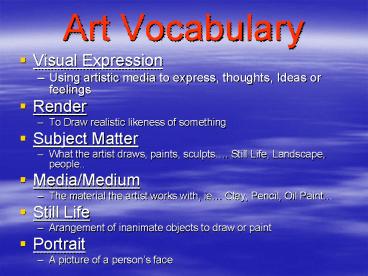Art Vocabulary - PowerPoint PPT Presentation
1 / 18
Title: Art Vocabulary
1
Art Vocabulary
- Visual Expression
- Using artistic media to express, thoughts, Ideas
or feelings - Render
- To Draw realistic likeness of something
- Subject Matter
- What the artist draws, paints, sculpts. Still
Life, Landscape, people.. - Media/Medium
- The material the artist works with, ie Clay,
Pencil, Oil Paint - Still Life
- Arangement of inanimate objects to draw or paint
- Portrait
- A picture of a persons face
2
- Thumbnail Sketch
- Quick sketches to determine composition
- Format
- The direction the composition faces
(Landscape/portrait) - Cropping
- How much the artist chooses to include
- View Finder
- A card with a rectangular hole in it, used for
cropping - Graphite
- Pencil lead
- Graded Pencils
- Varying degrees of softness and darkness of the
lead 6B soft and dark, 2B harder and
lighter
3
- Tooth
- The texture of the paper
- Newsprint
- The cheap sketch paper, has little, or no tooth,
very slick - White Sulphite
- The regular white drawing paper, has a moderate
tooth - Oaktag
- The slick/smooth white paper used for ink and
paint - Workable Fixative
- Spray to prevent smudging
- Matte Finish
- Spray to prevent smudging
4
Elements andPrinciples of Design
- Artists use the
- Principals of Art - (Rules)
- to Organize the
- Elements of Art - (Tools)
- to create
- Compositions
- The way the artist chooses to use the Elements
and Principals within his/her artwork.
5
Elements of Design
These are the most basic tools that are used to
create compositions or artworks.
Shape,
Line,
Form
Texture
Value
Color
6
Principals of Art - (Rules)
Contrast
Balance
Pattern
Emphasis
Unity
Rhythm
Movement
7
Line
- A Line is usually thought of as a mark made by a
drawing or painting instrument, like a pencil,
marker, or paint brush.
But a line can be so much more
8
Lines also direct eye movement.
- Vertical lines run perpendicular to the base of
the artwork. They tend to slow down eye movement
and are considered stable.
9
Horizontal lines run parallel to the base of the
artwork and are considered restful.
10
Diagonal lines move your eye into the artwork
quickly and create movement.
11
Curved lines change direction and express
activity.
12
Concentric Lines
- Concentric lines run parallel to other lines.
They can follow them inside or outside of
objects.
13
Implied Lines
Lines can be created by other means. They can be
series of things that your eye automatically
connects. They are suggested and not actual
lines. Things like
- Line of Sight
- Edges of objects
- Closure
- A line of dots
- A line of stitching on clothing
- A trail of foot prints
- A row of objects (chairs or desks)
- The list is endless
14
Outline
- Outlines show the inner and outer edges of
objects. They dont vary in thickness. They
look like the kinds of lines you generally find
in coloring books.
15
Contour lines
- Contour lines follow the edges of objects. They
follow the edges both inside and outside of
objects. They can have various widths and create
value on shapes. These lines generally vary in
widths. By making the lines thicker you can
create attached shadows.
16
Contour Line Drawing Assignment
In this project you will be using only contour
lines. You will create depth by varying the
width of your lines, particularly when they curve
around an object.
- Begin by making at least 2 Thumbnail sketches in
pencil in your workbook. You can have additional
news print if you like. - You may use an item such as a shoe or skate, or
other object in the boxes provided. - Use view finders to find strong compositions from
the thumbnails in your workbook. - Take 12 x 18 piece of tagboard.
- Float a rectangle of square on the paper that is
at least 10x10. This will create a frame for
you to work within. You can keep everything in
the frame, or have some things extend over the
frame or behind the frame.
17
Examples of former students work
18
More Examples of former students work































